I put down down the snow shovel to give my back a rest yesterday evening and couldn’t believe what I saw. Or didn’t see. Where was Venus? I looked to the south above the tree line and the goddess was gone! Sweeping my gaze to the right I found her again much closer to the western horizon point and also much lower.
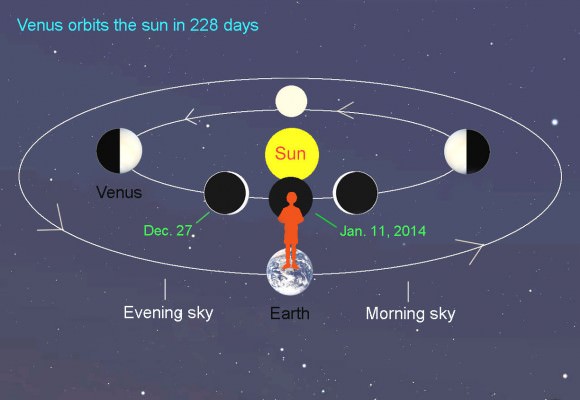
As 2013 gives way to the new year, Venus winds up its evening presentation as it prepares to transition to the morning sky. Catch it while you can. Each passing night sees the planet dropping ever closer to the horizon as its apparent distance from the sun shrinks. On January 11 it will pass through inferior conjunction as it glides between Earth and sun. Come the 12th, Venus nudges into the dawn sky – don’t expect to see it with the naked eye until around midmonth, when it’s far enough from the sun to bust through the twilight glare.
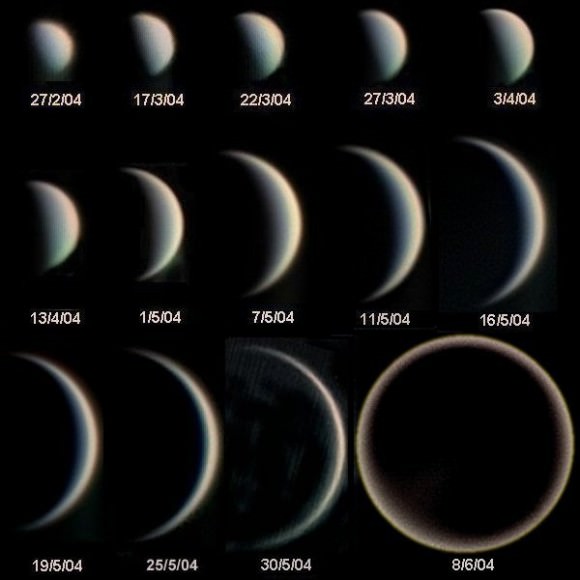
Though the planet is departing, don’t let it disappear without at least a glance through binoculars. As conjunction approaches, Venus gets as close (and as large) as it can get to Earth and displays a most attractive crescent phase. Even 7x binoculars will show its thinning sickle shortly at dusk. Tonight (Dec. 27) Venus measures nearly 1 arc minute in diameter or 1/30 the width of the full moon and shines brightly at magnitude -4.5.
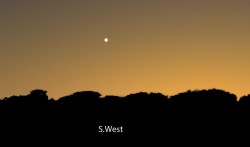
As the planet drops ever lower, the crescent grows both larger and thinner. A few days before conjunction, a telescope will show it extending beyond the usual 180-degree arc as sunlight beaming from behind Venus is scattered by the planet’s thick cloudy atmosphere.
When the air is transparent and seeing steady, amateur astronomers have photographed and observed the crescent wrapping a full 360 degrees around the planet’s disk – a sight quite unlike anything else in the sky.
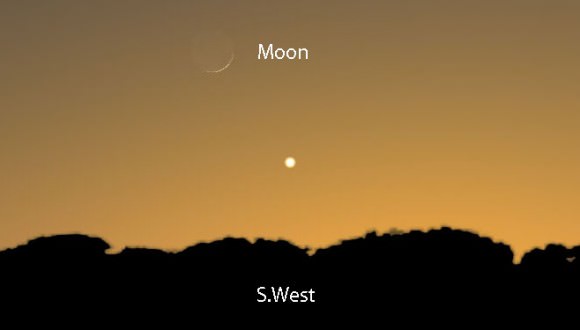
In the coming week, watch for Venus starting about 15 minutes after sunset low in the southwestern sky. With each day, the planet becomes slightly less conspicuous as it competes against the twilight glow.
After final farewells late next week, we’ll look forward in the new year to welcoming the goddess in her new guise as morning star.

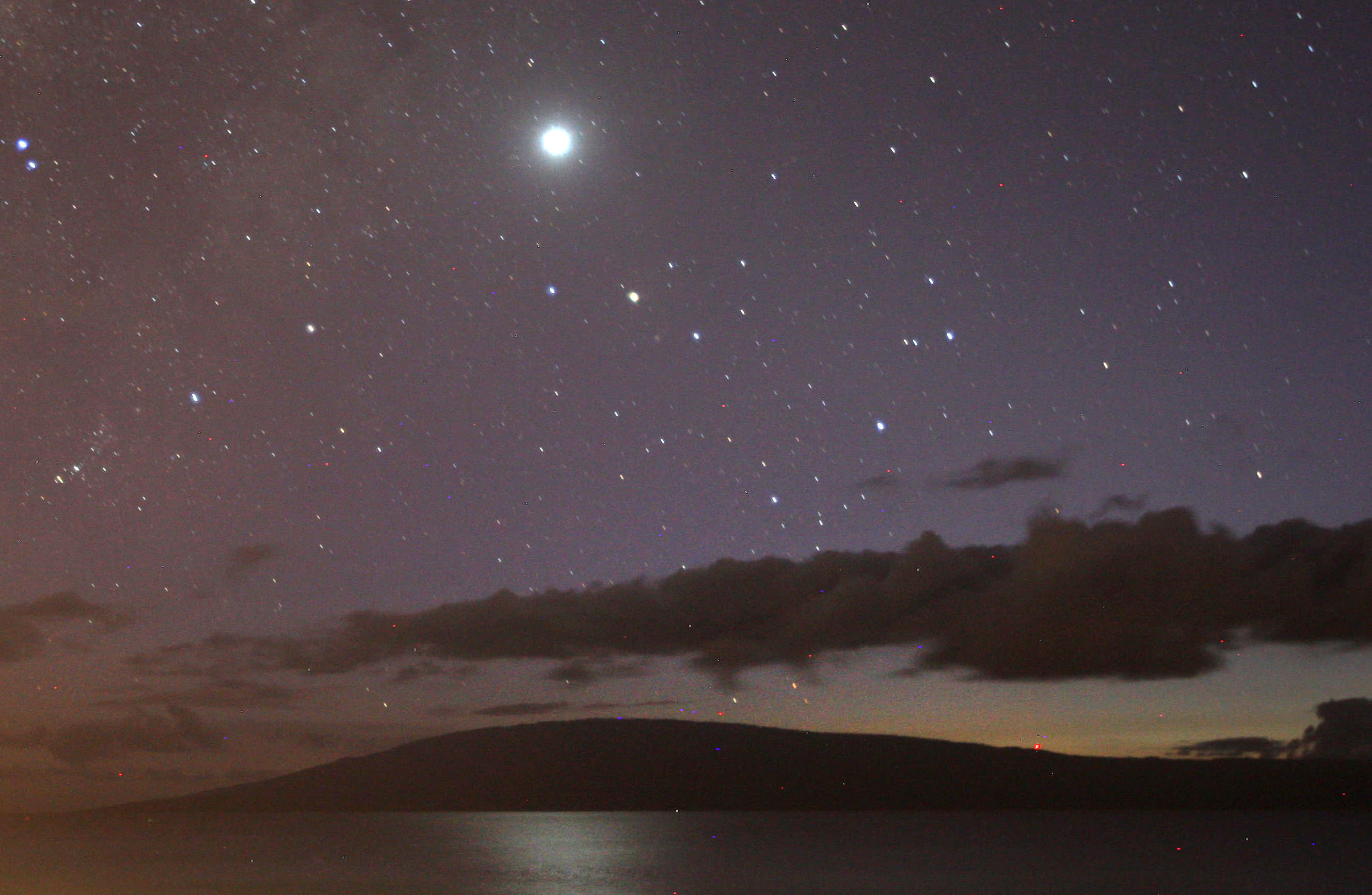
I sailed around the world with a gifted sextant and didn’t learn how to use it until I returned. One of life’s many regrets. The stars are especially intriguing when you realize how ancient navigators used them. And Venus the goddess, I enjoyed her on mornings coming into Australia from South Africa. That section of our trip was the longest trip ever made by a trawler yacht and the beautiful night skies reminded me of thousands of hours in my youth in an open sleigh behind the horses. The horses knew where to go like the ship on autopilot so nothing to do but look at the beautiful sky. idlewildexpedition.com
Link is broken.
Is this the site you were trying to reach?
http://idlewildexpedition.ca/index.php
yes my new site is out temporarily but my old site idlewildexpedition.ca works. Sorry for the confusion on my part
Thanks for info…
While Venus in focus, it may be good time to remember “Venera Program” (and “Camera Lens Cover” incident)…
“UT” editorial may consider it…
another helpful tip for viewing the crescentness of Venus is trying to find it b4 the sky gets dark. The earlier the better, pretty much. When the sky is dark Venus is so bright in comparison that the glare makes it more difficult to distinguish the edges of the lit portion, at least in binoculars. on Saturday i caught it about 11 minutes prior to sunset and since the surrounding sky was relatively light, there was less of a brightness gradient which meant a lot less glare. For the 1st time in my life (i think) i could CLEARLY see the crescent shape at 10x magnification, no problem whatsoever. other times i have kinda seen it but have wondered how much i was imagining it due to the glare obscuring the edges. it also helps that Venus is currently so “close” and with such a tiny lit portion facing us.
I looked tonight at Venus just at sunset, and it was easy to see the crescent Venus with binos. Thanks for the hint! I also saw the crescent moon within 40 hours of new moon–I’ve been waiting for clear skies to see this for 9 months! Now I can send my Lunar Observing Program data in to the Astronomical League. The KP index is already a 5–maybe an aurora sighting tonight while counting meteors for the Quadrantids. If only it we did not have a wind chill below zero!!! Thanks!
nice! i think my personal record for a young crescent is prior to the new moon, and i can’t remember how many hours but it may be similar, perhaps a little less. i have it written down somewhere. maybe i’ll look that up. another neat record to try is how close to solar noon/how small a crescent u can see. this works better on a very clear day in the summer since that is the best chance to spot such a small crescent, if it is high up in the sky when the sky is deep blue, putting yourself in shade with the area where the moon is still visible. i think my record for that is something like 2 days before the new moon.
just checked and my record is 31 hours, 32 minutes prior to new moon. for a mid-day sighting (within 2 hours of solar noon) my record is 63 hours and 36 minutes prior to new moon. i have never seen an aurora in my life, that i know of, and would love to. we had a snowstorm and below-zero wind chill for the quadrantid peak AM but yesterday AM did catch one!
The Astronomical League’s Lunar Observing Program includes observing the crescent moon waxing within 40 hours of new moon and waning withing 48 hours. We usually have clouds around new moon here in Wisconsin. I am glad to have finally finished the last item on the list! I woke up at 3am, thinking I might bundle up for the Quadrantids, but it was way too cold and windy. I saw a meteor the evening before–I decided that was enough. Tonight’s low is suppose to be a windchill of -54. Good time to read about astronomy. Loved the fond memories of your grandparents line…I could not come up with anything quite so fitting. LOL!
thanks. i missed the peak AM of the Quadtantids but went out the next AM (while it was below zero, almost no wind so not that bad) and happened to catch one. i plan to consistently attempt to see smaller moons (that is, a smaller lit portion) whenever i have the chance.